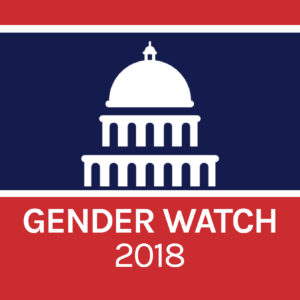Four Things You Need to Know about Women Voters
 From March to December 2018, the Barbara Lee Family Foundation (BLFF) and the Center for American Women and Politics (CAWP) partnered to offer Gender Watch 2018, which tracked, analyzed, and illuminated gender dynamics in the 2018 midterm elections. With the help of expert scholars and practitioners, Gender Watch 2018 furthered public understanding of how gender influences candidate strategy, voter engagement and expectations, media coverage, and electoral outcomes in campaigns. The blog below was written for Gender Watch 2018, as part of our collective effort to raise questions, suggest answers, and complicate popular discussions about gender’s role U.S. elections.
From March to December 2018, the Barbara Lee Family Foundation (BLFF) and the Center for American Women and Politics (CAWP) partnered to offer Gender Watch 2018, which tracked, analyzed, and illuminated gender dynamics in the 2018 midterm elections. With the help of expert scholars and practitioners, Gender Watch 2018 furthered public understanding of how gender influences candidate strategy, voter engagement and expectations, media coverage, and electoral outcomes in campaigns. The blog below was written for Gender Watch 2018, as part of our collective effort to raise questions, suggest answers, and complicate popular discussions about gender’s role U.S. elections.
After the conclusion of the Senate Confirmation Hearings, which featured powerful testimony from Dr. Christine Blasey Ford against Supreme Court nominee Brett Kavanaugh, 70 percent of Republican women continued to support his confirmation. This show of support came as a surprise to many people who expected Ford’s accusations of sexual assault to further polarize women voters, consistent with speculation that we will see a historic gender gap in the impending 2018 midterms.
We’ve been studying the gender gap in American politics for ten years, and our research suggests that Republican women’s continued support for Kavanaugh, and continued enthusiasm for the party generally, should come as no surprise. There is a tendency to associate women with the Democratic party, but liberalism isn’t the full story when it comes to women voters. In this era of heightened party polarization – where party identities are so strong and so distinct from one another – party loyalties play an outsized role in determining who people vote for on election day. And that goes for both men and women.
Democratic women are loyal to Democratic candidates. Republican women are loyal to Republican candidates. This is true even in situations where these party loyalties might be challenged, like races where gender issues are at the forefront because of sexual misconduct or because women are running in historic candidacies.
Yet, this isn’t the story the media is telling. Instead, they’ve suggested: The gender gap is becoming a gender chasm. Women prefer Democratic candidates by a record margin. Women are abandoning the Republican Party. GOP women are growing dissatisfied with their party. And GOP women are less motivated about voting.
Some Democrats are likely feeling pretty optimistic about this news. But this optimism is misplaced. Just because there are more women candidates running than ever before and gender has emerged as a common theme in the 2018 midterms, doesn’t mean that women are becoming more politically united.
Here are four things that you need to know to truly understand the gender gap.
1. Party identification trumps gender when it comes to voting.
Party identification is the most important factor for determining voting patterns. Both women and men rarely cross party lines to vote for opposition candidates. Yes, our research shows there has been a persistent and growing gender gap between the parties since the 1970s, with women more likely to identify as Democrats and men as Republicans. But once men and women choose to identify with a party, they stay pretty loyal to that party’s candidates.
There was a lot of speculation that 2016 would be an exception to this rule and that Republican women would vote for Hillary Clinton because of Donald Trump’s “woman problem.” But women largely remained loyal to their party. Exit polls show that 89 percent of Republican women voted for Trump. Similarly, 90 percent of Democratic women voted for Clinton.
Reporters are suggesting that Republican women may abandon their party in 2018. Consistent with past results, an October 2nd poll that found 55 percent of women said they would vote for a Democratic candidate for Congress compared to 43 percent of men, if the midterm elections were held today.
But this comparison isn’t very useful, because it doesn’t account for party affiliation.
If you use this same poll, but compare men and women from the same party, a different picture emerges. Ninety-three percent of Republican women and 91 percent of Republican men reported that they would vote for a Republican candidate for Congress if the election were held today. Just like in 2016, registered Republicans, whether male or female, plan to turn out for Republican candidates.
2. Party isn’t the only factor that divides women.
In addition to party, race, education, and class create sharp divisions among women. African-American women, Latinas, and college-educated women overwhelmingly support Democratic candidates. By contrast, a majority of white women typically vote Republican. In 2016, for example, 90 percent of women who voted for Trump were white. But, as our research shows, there are divisions among white women too. White women with a college degree were about twice as likely to support Clinton over Trump in 2016. On the other hand, low-income white women were much more supportive of Trump than middle- and upper-income women.
For the most part, these patterns are nothing new – they reflect long-standing trends in American political behavior. White women have long supported Republican presidential candidates, with the notable exception of Bill Clinton’s presidential bids in 1992 and 1996. The education gap among white women opened up in the 1990s, when a majority of college-educated white women started to support Democratic candidates. Taking race, education, and class into account like this quickly clears up the picture of the gender gap.
3. Women won’t automatically vote for a candidate just because she is also a woman.
A big part of the story about gender in the 2018 midterms is that there are more women running for office than ever before. Most of these female candidates are Democrats, and there is little to suggest that Republican women will cross party lines to vote for a female Democratic candidate. It’s not just a matter of party, but also a matter of policy.
In our research, we analyzed opinion in 10 different policy areas, and found that Republican women hold attitudes that are much more similar to Republican men than to Democrats of either gender. While Republican women have slightly more moderate views than Republican men on “women’s issues” – including education, child care, and healthcare – the gaps between parties are much bigger than differences between men and women within either party. Because Republican women have such conservative policy preferences, the spate of new female Democratic candidates is not likely to appeal to them.
Beyond this, many Republican women are perfectly happy being represented by men. In a poll conducted by CBS news, only 19 percent of Republican women think it is very important to elect more women or even that more women in political office would make the country better.
4. The gender gap doesn’t automatically benefit Democrats – turnout matters.
On average, women are more supportive of the Democratic party. Women are also more likely to turn out to vote compared to men. While this seems like it might automatically translate into a Democratic Party advantage, this isn’t necessarily the case. In 2016, white women turned out at higher than average rates, and the majority of them voted for Donald Trump. In the 2017 Special Election for Alabama Senate, African- American women turned out at unusually high rates, solidifying a victory for Democrat Doug Jones over Republican candidate Roy Moore.
What can we expect in terms of turnout in the 2018 midterms?
Although a July 2nd poll of registered voters found that Democratic women were 10 percentage points more likely than Republican women to say the November elections are “very important,” this enthusiasm gap has disappeared in the wake of the Kavanaugh hearings. An October 1st poll of registered voters showed that 79 percent of Democratic women and 83 percent of Republican women now believe that the upcoming midterm is “very important” – a statistical tie.
Ultimately, women are not a unified group politically, and we should be skeptical of reporting on the gender gap that suggests they are. Partisanship plays a powerful role in shaping women’s voting behavior and any one particular event or candidate is unlikely to override the power of party loyalty and create a major electoral upheaval.


